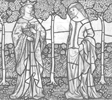|
What's "high fantasy"?
When I was a kid, that meant J. R. R. Tolkien.
You know, make-believe worlds with monsters, magic, maps, and muttering in made-up languages.
Not the pulp fiction stuff, but quality literature accessible to egg-headed 12 year olds.
Now, I hadn't touched Tolkien since childhood, but then the Lord Of The Rings movies came out and I was hooked again - me and a billion other people.
Unlike a billion other people, however, I got strangely obsessed with the question, "Where the heck did Tolkien come up with this stuff?"
Actually, if I'd been paying any attention I would have realized he got his ideas straight from sources like Beowulf and Norse mythology, and probably honestly claimed to be almost completely uninfluenced by modern high fantasy novels.
But being an idiot intent on wasting vast amounts of leisure time, I embarked on a quest to find truly Tolkien-esque novels that predated the master himself, and some of Tolkien's more obscure works like The Silmarillion.
My quest failed, kind of, except that I discovered E. R. Eddison's strange, parallel development of a Middle Earth-like world - really the closest thing to Tolkien before Tolkien.
I had some fun with other early authors like William Morris, the pre-Raphaelite designer who invented the modern high fantasy genre in the 1890s, drawing on medieval sources like the Arthurian Legends, and Lord Dunsany, the poetic genius who brought in mysterious made-up proper nouns and pantheons.
I took a detour with the high fantasy satires of Dunsany's American contemporary, James Branch Cabell.
I also read other idiosyncratic writers of the 1920s like David Lindsay and Hope Mirrlees, not to mention the equally flaky 1950s Gothic fantasist Mervyn Peake and the pulpy, homoerotic 60s and 70s Classics scholar Thomas Burnett Swann.
I tried to stay away from old sword & sorcery hacks like Robert Ervin Howard, or the classic sword & planet adventures of Edgar Rice Burroughs.
I figured Wilson would deal with that for me, not to mention other pulp writers like A. Merritt and C. L. Moore (what a swell guy).
But I was only pretending to have outgrown my childhood, because I moved on to pulp fantasists of the 30s and 40s like Clark Ashton Smith, H. P. Lovecraft, Hannes Bok, Fletcher Pratt, and Fritz Leiber, who brought action and adventure to Dunsany's ethereal formula.
Getting more and more desperate, I read fantasy dabblers like the 60s science fiction writers Poul Anderson, Robert Heinlein, and Roger Zelazny, none of whom were able to pump out this stuff with a straight face - but then I discovered the marvelous, highly literary fantasy work of their science fiction colleague Ursula K. Le Guin.
I also looked into early 70s high fantasy writers like Evangeline Walton, who came out of retirement to profit from the Tolkien boom, and Joy Chant, perhaps the first writer to shamelessly, utterly imitate the grand master himself.
And now I'm drifting into an encounter with 60s and early 70s sword & sorcery writers like Michael Moorcock.
Now obviously, I'm not done wasting my time yet.
My guiding light in all this has been the late 60s and early 70s Ballantine Adult Fantasy series, edited by Lin Carter, which revived most of the classic pre-Tolkien novels that had fallen into obscurity in the mid-20th century.
I'm now systematically working through the books in that series that are closest to the high fantasy genre.
And I have tons and tons and tons of books on my bookshelf left to look at, including works by female 60s and 70s writers like Gaskell, Kurtz, and Norton, many of their male contemporaries like Christopher, Davidson, and Garner, and a few older writers like Munn and Vance.
|

